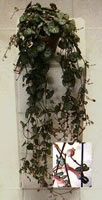How to Grow and Care for Your Rosary Vine
Ceropegia woodii
        
 
Hi, I was wondering if you could tell me if you have heard of a plant called chain of hearts
or also I have heard it called Hawaiian potato ball
It's a vine with no blooms an has very small leaves that look like hearts.
Any info would be appreciated. thank you
|
From your description, I believe your plant is a Ceropegia woodii.
It is also commonly known as a Rosary Plant, Rosary Vine, Hearts Entangled, or String of Hearts.....
The Rosary plant makes an excellent container grown house plant due to it's durability.
Rosary Plants can endure neglect, dry air, and drought but quickly bounce back to life with a single watering.
(I'm not saying that you should neglect it!)
Ceropegias are only hardy in USDA zones 10 and 11
The vines of the Rosary Plant are like thin wires with marbled, heart shaped leaves.
Each vine will reach two to four feet in length, so the plant should be hung or set on a pedestal where it will receive bright light for most of the
day.
Full sun is ok, if some protection is provided during the hottest part of the day
Rosary Vines prefer summer temperatures around 70-75°, but during the winter, when the plant goes dormant,
it should be kept in a cooler room if possible (60-65°).
The Rosary Plant is somewhat succulent, so use care to never overwater, or allow the plant to set in water.
Water thoroughly but allow the soil to completely dry out before watering again.
During the active growing period of spring and summer, your Rosary plant should be fed monthly with a liquid houseplant food diluted to half strength.
|

|
|
Repotting your Rosary Vine
Use a porous potting soil with coarse sand added when you repot this vine in early spring, making sure to provide adequate drainage.
|
|
Unique Features of the Rosary Vine
The slender flowers resemble an inverted pink vase.
The end of the tube is partly closed by delicate, crossed purple bars.
You'll find that hummingbirds are attracted to the flowers if your plant is hung in your garden during the summer months.
Propagating New Rosary Plants
The beads are small (¼-½") tubers which form along the stem below the leaf bases.
These beads can be planted to propagate new vines. Just press the tuber into the soil, and keep it moist (not wet)
If possible, plant the bead while it is still attached to the mother plant, for speedier rooting.
Once rooted and growing, the new plant can be easily severed from the main plant. |
Rosary Plant
Ceropegia woodii
 |
|
|
|
Search The Garden Helper:

